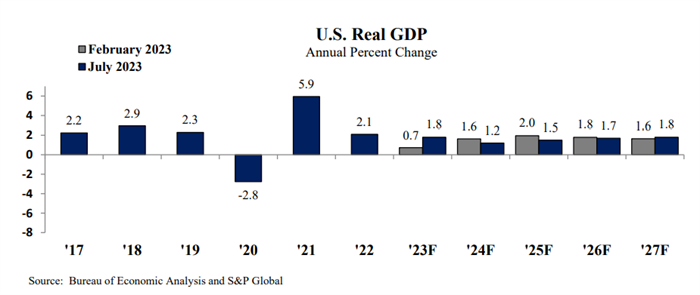The State of Minnesota ended the most recent fiscal year on a positive revenue note. Looking ahead, the national economic picture is expected to be stronger in 2023 but weaker in the following years, according to the
July Revenue and Economic Update from Minnesota Management and Budget (MMB).
Some of the top takeaways from the update include:
1.
Nationally, economic growth is expected, but generally weaker after 2023 than earlier predicted. Forecasters now predict stronger GDP growth in 2023 -- 1.8 percent compared to the 0.7 percent predicted in the February forecast. However, in the following two years, GDP growth is expected to slow to 1.2 in 2024 and 1.5 percent in 2025. These are lower rates of growth projected for these years than in February. The Economic Update notes that its economic growth projections are more optimistic than the Blue Chip Consensus, another highly-regarded economic projection. Inflation has slowed down considerably since last year; the economic outlook now expects 4.1 percent CPI inflation in 2023 and 2.7 percent in 2024; these are slightly higher inflation projections for these years than in February.

2.
State fiscal year 2023 revenues came in slightly higher compared to the February forecast. Revenues for Minnesota’s FY 2023, which ended on June 30, came in $529 million, or 1.8 percent, higher than February projections. Individual income tax revenue was the largest source of this increase, followed by the corporate franchise tax. These FY 2023 numbers are preliminary, and a fuller report for the year will be available in the October economic update.
3.
The official unemployment rate is low now. In June, the national unemployment rate was 3.6 percent. About 6 million workers across the country are unemployed, which is just 200,000 more people without jobs than in February 2020, before the pandemic hit. However, the update predicts that the U.S. unemployment rate will climb to 4.8 percent by mid-2026 before declining again in 2027.
Our take on what this might suggest
This week’s update brings us short-term good news: the most recent fiscal year ended with state revenues doing a little better than projections, and the national economy is growing at a decent pace this year. However, lower economic growth projected for the future gives us pause, as it suggests a greater risk of a recession.
Fortunately, Minnesota has a strong budget reserve, which is a critical part of the state being prepared for the next economic downturn. In the same way a family saves to withstand an unexpected serious illness or job loss, Minnesota builds this reserve so that when a recession hits and state revenues plummet, the state can avoid drastic cuts in critical services and continue to serve Minnesotans’ needs.
Additionally, Minnesota policymakers recently enacted transformational changes in the 2023 Legislative Session so that more Minnesotans have access to affordable health insurance, paid leave, and other supports to better weather fluctuations in the economy and job market. They should follow that with additional steps to shore up supports for folks when they hit tough times – including
modernizing our state’s UI system to better match today’s workforce, and thoughtfully implementing the state’s new health care and paid leave improvements to ensure that no one is left behind.